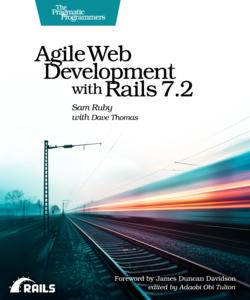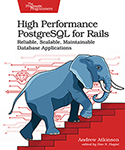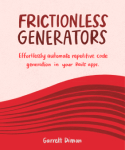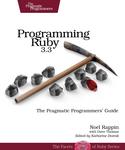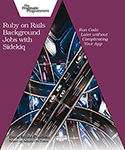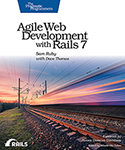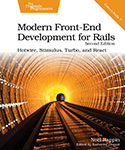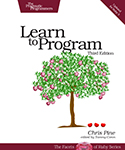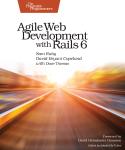About This Title
Pages: 472
Published: March 2025
ISBN: 9798888651049
In Print

Agile Web Development with Rails 7.2
by Sam Ruby
Rails 7.2 completely redefined what it means to produce fantastic user experiences and provides a way to achieve all the benefits of single-page applications—at a fraction of the complexity. Rails 7.2 integrated the Hotwire frameworks of Stimulus and Turbo directly as the new defaults, together with that hot newness of import maps. The result is a toolkit so powerful that it allows a single individual to create modern applications upon which they can build a competitive business. The way it used to be.
This purchase includes the Rails 7 book at no additional cost.
eBook Formats:
PDF for desktop/tablets
epub for Apple Books, e-readers
mobi for Kindle readers
Get all eBook formats here for $39.95 (USD)
Paperback Formats:
Order via Bookshop (U.S. Only)
Please support indie bookstores!
Find indie bookstores in the U.S. Find indie bookstores around the world.
Ruby on Rails helps you produce high-quality, beautiful-looking web applications quickly—you concentrate on creating the application, and Rails takes care of the details. Rails 7.2 brings many improvements, and this edition is updated to cover the new features and changes in best practices.
We start with a step-by-step walkthrough of building a real application, and in-depth chapters look at the built-in Rails features. Follow along with an extended tutorial as you write a web-based store application. Eliminate tedious configuration and housekeeping, seamlessly incorporate JavaScript, send and receive emails, manage background jobs with ActiveJob, and build real-time features using WebSockets and ActionCable. Test your applications as you write them using the built-in unit, integration, and system testing frameworks, internationalize your applications, and deploy your applications easily and securely.
Rails 1.0 was released in December 2005. This book was there from the start, and didn’t just evolve alongside Rails, it evolved with Rails. It has been developed in consultation with the Rails core team. In fact, Rails itself is tested against the code in this book.
What You Need
All you need is a Windows, Mac OS X, or Linux machine to do development on. This book will take you through the steps to install Rails and its dependencies. If you aren’t familiar with the Ruby programming language, this book contains a chapter that covers the basics necessary to understand the material in the book.Resources
Releases:
Contents & Extracts
- Getting Started
- Installing Rails
- Installing on Windows
- Installing on macOS
- Installing on Linux
- Choosing a Rails Version
- Setting Up Your Development Environment
- Rails and Databases
- Instant Gratification
- Creating a New Application
- Hello,
Rails!

- Linking Pages Together
- When Things Go Wrong
- The Architecture of Rails Applications
- Models, Views, and Controllers
- Rails Model Support
- Action Pack: The View and Controller
- Introduction to Ruby
- Ruby Is an Object-Oriented Language
- Data Types
- Logic
- Organizing Structures
- Marshaling Objects
- Pulling It All Together
- Ruby Idioms
- Installing Rails
- Building an Application
- The Depot Application
- Incremental Development
- What Depot Does
- Let’s Code
- Task A: Creating the Application
- Iteration A1: Creating the Product Maintenance Application
- Iteration A2: Making Prettier Listings
- Task B: Validation and Unit Testing
- Iteration B1: Validating!
- Iteration B2: Unit Testing of Models
- Task C: Catalog Display
- Iteration C1: Creating the Catalog
Listing

- Iteration C2: Adding a Page Layout
- Iteration C3: Using a Helper to Format the Price
- Iteration C4: Functional Testing of Controllers
- Iteration C5: Caching of Partial Results
- What We Just Did
- Iteration C1: Creating the Catalog
Listing
- Task D: Cart Creation
- Iteration D1: Finding a Cart
- Iteration D2: Connecting Products to Carts
- Iteration D3: Adding a Button
- Task E: A Smarter Cart
- Iteration E1: Creating a Smarter Cart
- Iteration E2: Handling Errors
- Iteration E3: Finishing the Cart
- Task F: Hotwiring the Storefront
- Iteration F1: Moving the Cart
- Iteration F2: Creating a Hotwired Cart
- Iteration F3: Highlighting Changes
- Iteration F4: Broadcasting Updates with Action Cable
- Task G: Check Out!
- Iteration G1: Capturing an Order
- Iteration G2: Adding Fields Dynamically to a Form
- Iteration G3: Testing Our JavaScript Functionality
- Task H: Sending Emails and Processing Payments Efficiently
- Iteration H1: Sending Confirmation Emails
- Iteration H2: Connecting to a Slow Payment Processor with Active Job
- Task I: Logging In
- Iteration I1: Adding Users
- Iteration I2: Authenticating Users
- Iteration I3: Limiting Access
- Iteration I4: Adding a Sidebar, More Administration
- Task J: Internationalization
- Iteration J1: Selecting the
Locale

- Iteration J2: Translating the Storefront
- Iteration J3: Translating Checkout
- Iteration J4: Adding a Locale Switcher
- Iteration J1: Selecting the
Locale
- Task K: Receive Emails and Respond with Rich Text
- Iteration K1: Receiving Support Emails with Action Mailbox
- Iteration K2: Storing Support Requests from Our Mailbox
- Iteration K3: Responding with Rich Text
- Task L: Deployment and Production
- Overview of the Changes
- Configuring the Databases
- Managing Secrets
- Building a Docker Image
- Getting Up and Running
- Depot Retrospective
- Rails Concepts
- Documenting What We’ve Done
- The Depot Application
- Rails in Depth
- Finding Your Way Around Rails
- Where Things Go
- Naming Conventions
- Active Record
- Defining Your Data
- Locating and Traversing Records
- Creating, Reading, Updating, and Deleting (CRUD)
- Participating in the Monitoring Process
- Transactions
- Action Dispatch and Action Controller
- Dispatching Requests to Controllers
- Processing of Requests
- Objects and Operations That Span Requests
- Action View
- Using Templates
- Generating Forms
- Processing Forms
- Uploading Files to Rails Applications
- Using Helpers
- Reducing Maintenance with Layouts and Partials
- Migrations
- Creating and Running Migrations
- Anatomy of a Migration
- Managing Tables
- Advanced Migrations
- When Migrations Go Bad
- Schema Manipulation Outside Migrations
- Customizing and Extending Rails
- Creating a Reusable Web Component
- Testing with RSpec
- Creating HTML Templates with Slim
- Customizing Rails in Other Ways
- Where to Go from Here
- Finding Your Way Around Rails
Author
Sam Ruby is a Rails Specialist at Fly.io, and previously was President of the Apache Software Foundation, co-chaired the W3C HTML Working Group, and has made significant contributions to many open source projects and standards.
Dave Thomas, as one of the authors of the Agile Manifesto, understands agility. As the author of Programming Ruby, he understands Ruby. And, as an active Rails developer, he knows Rails.
eBook Formats:
PDF for desktop/tablets
epub for Apple Books, e-readers
mobi for Kindle readers
Get all eBook formats here for $39.95 (USD)
Paperback Formats:
Order via Bookshop (U.S. Only)
Please support indie bookstores!
Find indie bookstores in the U.S. Find indie bookstores around the world.
Related Titles:

About This Title
Pages: 472
Published: March 2025
ISBN: 9798888651049
Edition: 1
In Print
